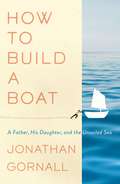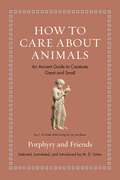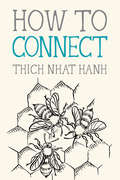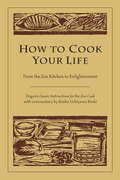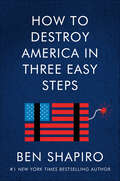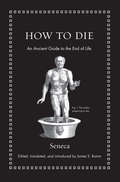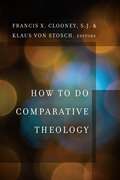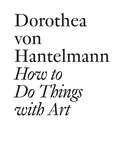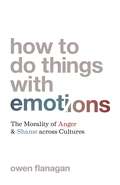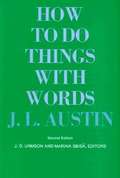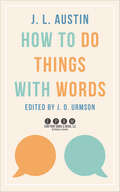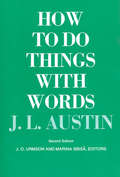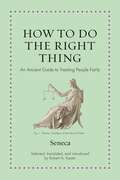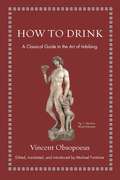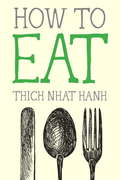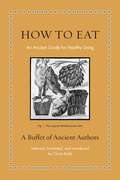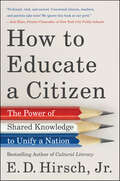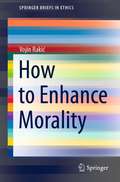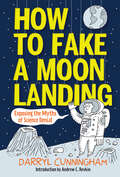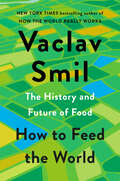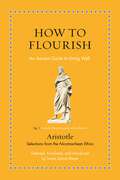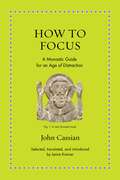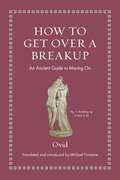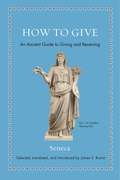- Table View
- List View
How to Build a Boat: A Father, His Daughter, and the Unsailed Sea
by Jonathan GornallPart ode to building something with one’s hands in the modern age, part celebration of the beauty and function of boats, and part moving father-daughter story, How to Build a Boat is a bold adventure.Once an essential skill, the ability to build a clinker boat, first innovated by the Vikings, can seem incomprehensible today. Yet it was the clinker, with its overlapping planks, that afforded us access to the oceans, and its construction has become a lost art that calls to the do-it-yourselfer in all of us. John Gornall heard the call. A thoroughly unskilled modern man, Gornall set out to build a traditional wooden boat as a gift for his newborn daughter. It was, he recognized, a ridiculously quixotic challenge for a man who knew little about woodworking and even less about boat-building. He wasn’t even sure what type of wood he should use, the tools he’d need, or where on earth he'd build the boat. He had much to consider…and even more to learn. But, undaunted, he embarked on a voyage of rediscovery, determined to navigate his way back to a time when we could fashion our future and leave our mark on history using only time-honored skills and the materials at hand. His journey began in East Anglia, on England’s rocky eastern coast. If all went according to plan, it would end with a great adventure, as father and daughter cast off together for a voyage of discovery that neither would forget, and both would treasure until the end of their days. How to Build a Boat celebrates the art of boat-building, the simple pleasures of working with your hands, and the aspirations and glory of new fatherhood. John Gornall “tells the inspiring story of how even the least skilled of us can make something wonderful if we invest enough time and love” (The Daily Mail) and taps into the allure of an ancient craft, interpreting it in a modern way, as tribute to the generations yet to come. “Both the book, and place, are magical” (The Sunday Telegraph).
How to Care about Animals: An Ancient Guide to Creatures Great and Small (Ancient Wisdom for Modern Readers)
by M. D. UsherAn entertaining and enlightening anthology of classical Greek and Roman writings on animals—and our vital relationships with themHow to Care about Animals is a fascinating menagerie of passages from classical literature about animals and the lives we share with them. Drawing on ancient writers from Aesop to Ovid, classicist and farmer M. D. Usher has gathered a healthy litter of selections that reveal some of the ways Greeks and Romans thought about everything from lions, bears, and wolves to birds, octopuses, and snails—and that might inspire us to rethink our own relationships with our fellow creatures. Presented in lively new translations, with the original texts on facing pages, these pieces are filled with surprises—anticipating but also offering new perspectives on many of our current feelings and ideas about animals.Here, Porphyry makes a compelling argument for vegetarianism and asserts that the just treatment of animals makes us better people; Pliny the Elder praises the virtuosity of songbirds and the virtuousness of elephants; Plutarch has one of Circe’s pigs from the Odyssey make a serio-comic case for the dignity of the beasts of the field; Aristotle puts the study of animals on par with anthropology; we read timeless Aesopian fables, including “The Hen That Laid the Golden Egg” and “The Fox and the Grapes”; and there is much, much more.A Noah’s Ark of a book, How to Care about Animals is guaranteed to charm and inspire anyone who loves animals.
How to Connect (Mindfulness Essentials #8)
by Thich Nhat HanhWe can restore our inherent connection to nature, each other, our ancestors, and ourselves, and remember our fundamental gift of belonging. The eighth book in the bestselling Mindfulness Essentials series, a back-to-basics collection from world-renowned Zen master Thich Nhat Hanh that introduces everyone to the essentials of mindfulness practice. "We are here to awaken from the illusion of our separateness."—Thich Nhat HanhWith our world experiencing the deep effects of loneliness, environmental detachment, and digital overload, this pocket-sized How To book reminds us of our crucial need to connect to ourselves, our ancestors, and our planet. Written with characteristic simplicity and kindness, these wise meditations teach us how to remember, at any time, our fundamental gift of belonging. Illustrated with playful sumi-ink drawings by California artist Jason DeAntonis.
How to Cook Your Life: From the Zen Kitchen to Enlightenment
by Kosho Uchiyama Roshi DogenIn the thirteenth century, Zen master Dogen—perhaps the most significant of all Japanese philosophers, and the founder of the Japanese Soto Zen sect—wrote a practical manual of Instructions for the Zen Cook. In drawing parallels between preparing meals for the Zen monastery and spiritual training, he reveals far more than simply the rules and manners of the Zen kitchen; he teaches us how to "cook," or refine our lives. In this volume Kosho Uchiyama Roshi undertakes the task of elucidating Dogen's text for the benefit of modern-day readers of Zen. Taken together, his translation and commentary truly constitute a "cookbook for life," one that shows us how to live with an unbiased mind in the midst of our workaday world.
How to Destroy America in Three Easy Steps
by Ben ShapiroA NEW YORK TIMES BESTSELLER!A growing number of Americans want to tear down what it’s taken us 250 years to build—and they’ll start by canceling our shared history, ideals, and culture.Traditional areas of civic agreement are vanishing. We can’t agree on what makes America special. We can’t even agree that America is special. We’re coming to the point that we can’t even agree what the word America itself means. “Disintegrationists” say we’re stronger together, but their assault on America’s history, philosophy, and culture will only tear us apart.Who are the disintegrationists? From Howard Zinn’s A People’s History of the United States to the New York Times’ 1619 project, many modern analyses view American history through the lens of competing oppressions, a racist and corrupt experiment from the very beginning. They see American philosophy as a lie – beautiful words pasted over a thoroughly rotted system. They see America’s culture of rights as a façade that merely reinforces traditional hierarchies of power, instead of being the only culture that guarantees freedom for individuals.Disintegrationist attacks on the values that built our nation are insidious because they replace each foundational belief, from the rights to free speech and self-defense to the importance of marriage and faith communities, with nothing more than an increased reliance on the government. This twisted disintegrationist vision replaces the traditional “unionist” understanding that all Americans are united in a shared striving toward the perfection of universal ideals.How to Destroy America in Three Easy Steps shows that to be a cohesive nation we have to uphold foundational truths about ourselves, our history, and reality itself—to be unionists instead of disintegrationists. Shapiro offers a vital warning that if we don’t recover these shared truths, our future—our union—as a great country is threatened with destruction.
How to Die: An Ancient Guide to the End of Life
by Seneca James S. RommTimeless wisdom on death and dying from the celebrated Stoic philosopher Seneca"It takes an entire lifetime to learn how to die," wrote the Roman Stoic philosopher Seneca (c. 4 BC–65 AD). He counseled readers to "study death always," and took his own advice, returning to the subject again and again in all his writings, yet he never treated it in a complete work. How to Die gathers in one volume, for the first time, Seneca's remarkable meditations on death and dying. Edited and translated by James S. Romm, How to Die reveals a provocative thinker and dazzling writer who speaks with a startling frankness about the need to accept death or even, under certain conditions, to seek it out. Seneca believed that life is only a journey toward death and that one must rehearse for death throughout life. Here, he tells us how to practice for death, how to die well, and how to understand the role of a good death in a good life. He stresses the universality of death, its importance as life's final rite of passage, and its ability to liberate us from pain, slavery, or political oppression. Featuring beautifully rendered new translations, How to Die also includes an enlightening introduction, notes, the original Latin texts, and an epilogue presenting Tacitus's description of Seneca's grim suicide.
How to Do Comparative Theology (Comparative Theology: Thinking Across Traditions)
by Francis X. Clooney, S.J., and Klaus Von StoschFor a generation and more, the contribution of Christian theology to interreligious understanding has been a subject of debate. Some think of theological perspectives are of themselves inherently too narrow to support interreligious learning, and argue for an approach that is neutral or, on a more popular level, grounded simply open-minded direct experience. In response, comparative theology argues that theology, as faith seeking understanding, offers a vital perspective and a way of advancing interreligious dialogue, aided rather than hindered by commitments; theological perspectives can both complement and step beyond the study of religions by methods detached and merely neutral. Thus comparative theology has been successful in persuading many that interreligious learning from one faith perspective to another is both possible and worthwhile, and so the work of comparative theology has become more recognized and established globally. With this success there has come to the fore new challenges regarding method: How does one do comparative theological work in a way that is theologically grounded, genuinely open to learning from the other, sophisticated in pursuing comparisons, and fruitful on both the academic and practical levels? How To Do Comparative Theology therefore contributes to the maturation of method in the field of comparative theological studies, learning across religious borders, by bringing together essays drawing on different Christian traditions of learning, Judaism and Islam, Hinduism and Buddhism, the wisdom of senior scholars, and also insights from a younger generation of scholars who have studied theology and religion in new ways, and are more attuned to the language of the “spiritual but not religious.” The essays in this volume show great diversity in method, and also—over and again and from many angles—coherence in intent, a commitment to one learning from the other, and a confidence that one’s home tradition benefits from fair and unhampered learning from other and very different spiritual and religious traditions. It therefore shows the diversity and coherence of comparative theology as an emerging discipline today.
How to Do Things with Art
by Dorothea Von HantelmannPart of JRP|Ringer's innovative Documents series, published with Les Presses du Réel and dedicated to critical writings, this publication comprises a unique collection of interviews by Hans Ulrich Obrist mapping the development of the curatorial field--from early independent curators in the 1960s and 70s and the experimental institutional programs developed in Europe and the U.S. through the inception of Documenta and the various biennales and fairs--with pioneering curators Anne D'Harnoncourt, Werner Hoffman, Jean Leering, Franz Meyer, Seth Siegelaub, Walter Zanini, Johannes Cladders, Lucy Lippard, Walter Hopps, Pontus Hulten and Harald Szeemann. Speaking of Szeemann on the occasion of this legendary curator's death in 2005, critic Aaron Schuster summed up, "the image we have of the curator today: the curator-as-artist, a roaming, freelance designer of exhibitions, or in his own witty formulation, a 'spiritual guest worker'... If artists since Marcel Duchamp have affirmed selection and arrangement as legitimate artistic strategies, was it not simply a matter of time before curatorial practice--itself defined by selection and arrangement--would come to be seen as an art that operates on the field of art itself?"
How to Do Things with Emotions: The Morality of Anger and Shame across Cultures
by Owen FlanaganAn expansive look at how culture shapes our emotions—and how we can benefit, as individuals and a society, from less anger and more shameThe world today is full of anger. Everywhere we look, we see values clashing and tempers rising, in ways that seem frenzied, aimless, and cruel. At the same time, we witness political leaders and others who lack any sense of shame, even as they display carelessness with the truth and the common good. In How to Do Things with Emotions, Owen Flanagan explains that emotions are things we do, and he reminds us that those like anger and shame involve cultural norms and scripts. The ways we do these emotions offer no guarantee of emotionally or ethically balanced lives—but still we can control and change how such emotions are done. Flanagan makes a passionate case for tuning down anger and tuning up shame, and he observes how cultures around the world can show us how to perform these emotions better.Through comparative insights from anthropology, psychology, and cross-cultural philosophy, Flanagan reveals an incredible range in the expression of anger and shame across societies. He establishes that certain types of anger—such as those that lead to revenge or passing hurt on to others—are more destructive than we imagine. Certain forms of shame, on the other hand, can protect positive values, including courage, kindness, and honesty. Flanagan proposes that we should embrace shame as a uniquely socializing emotion, one that can promote moral progress where undisciplined anger cannot.How to Do Things with Emotions celebrates the plasticity of our emotional responses—and our freedom to recalibrate them in the pursuit of more fulfilling lives.
How to Do Things with Sensors (Forerunners: Ideas First)
by Jennifer GabrysAn investigation of how-to guides for sensor technologies Sensors are increasingly common within citizen-sensing and DIY projects, but these devices often require the use of a how-to guide. From online instructional videos for troubleshooting sensor installations to handbooks for using and abusing the Internet of Things, the how-to genres and formats of digital instruction continue to expand and develop. As the how-to proliferates, and instructions unfold through multiple aspects of technoscientific practices, Jennifer Gabrys asks why the how-to has become one of the prevailing genres of the digital. How to Do Things with Sensors explores the ways in which things are made do-able with and through sensors and further considers how worlds are made sense-able and actionable through the instructional mode of citizen-sensing projects.Forerunners: Ideas FirstShort books of thought-in-process scholarship, where intense analysis, questioning, and speculation take the lead
How to Do Things with Words
by J. L. Austin J. O. Urmson Marina SbisàJohn L. Austin was one of the leading philosophers of the twentieth century. The William James Lectures presented Austin's conclusions in the field to which he directed his main efforts on a wide variety of philosophical problems. These talks became the classic How to Do Things with Words
How to Do Things with Words
by J. L. AustinIn this seminal series of lectures by the noted British philosopher, J.L. Austin explores the profound ways in which language is not just a vehicle for conveying information but also a tool for performing actions. He introduces the concept of the performative utterance -- later called dubbed a speech-act -- which are utterances that not only convey meaning but also have the power to bring about changes in the world. The book also delves into the complexities of language, meaning, and context, highlighting how linguistic conventions and social norms shape our understanding of words. Austin's work challenges conventional views on language, emphasizing that words have the power to do things and not just describe things.
How to Do Things with Words: Second Edition (Oxford Paperbacks Ser. #1)
by J. L. AustinJohn L. Austin was one of the leading philosophers of the twentieth century. The William James Lectures presented Austin’s conclusions in the field to which he directed his main efforts on a wide variety of philosophical problems. These talks became the classic How to Do Things with Words. For this second edition, the editors have returned to Austin’s original lecture notes, amending the printed text where it seemed necessary. Students will find the new text clearer, and, at the same time, more faithful to the actual lectures. An appendix contains literal transcriptions of a number of marginal notes made by Austin but not included in the text. Comparison of the text with these annotations provides new dimensions to the study of Austin’s work.
How to Do the Right Thing: An Ancient Guide to Treating People Fairly (Ancient Wisdom for Modern Readers)
by SenecaHow ancient Stoicism can help teach us to treat others—and ourselves—more fairly and mercifully There are times when we&’ve all felt that we haven&’t been treated as we deserve—that we&’ve been misjudged, shortchanged, or given a raw deal. And, at one time or another, other people have probably felt that we&’ve treated them just as unfairly. How to Do the Right Thing draws on the principles of ancient Stoicism as articulated by the Roman statesman and philosopher Seneca to help readers better navigate one of the most important practical questions of daily life—how to do right by others.Starting from the virtue of magnanimity—the opposite of small-mindedness—How to Do the Right Thing draws together lessons from Seneca&’s writings that stress the importance of calm and clear thinking, of judging oneself fairly before judging others, and of cutting people slack, with a bias toward mercy—all delivered in crisp and lively new translations, and with the original Latin on facing pages.
How to Drink: A Classical Guide to the Art of Imbibing (Ancient Wisdom for Modern Readers)
by Vincent ObsopoeusA spirited new translation of a forgotten classic, shot through with timeless wisdom Is there an art to drinking alcohol? Can drinking ever be a virtue? The Renaissance humanist and neoclassical poet Vincent Obsopoeus (ca. 1498–1539) thought so. In the winelands of sixteenth-century Germany, he witnessed the birth of a poisonous new culture of bingeing, hazing, peer pressure, and competitive drinking. Alarmed, and inspired by the Roman poet Ovid's Art of Love, he wrote The Art of Drinking (De Arte Bibendi) (1536), a how-to manual for drinking with pleasure and discrimination. In How to Drink, Michael Fontaine offers the first proper English translation of Obsopoeus's text, rendering his poetry into spirited, contemporary prose and uncorking a forgotten classic that will appeal to drinkers of all kinds and (legal) ages.Arguing that moderation, not abstinence, is the key to lasting sobriety, and that drinking can be a virtue if it is done with rules and limits, Obsopoeus teaches us how to manage our drinking, how to win friends at social gatherings, and how to give a proper toast. But he also says that drinking to excess on occasion is okay—and he even tells us how to win drinking games, citing extensive personal experience.Complete with the original Latin on facing pages, this sparkling work is as intoxicating today as when it was first published.
How to Eat (Mindfulness Essentials)
by Thich Nhat Hanh Jason DeantonisHow to Eat is part of the Mindfulness Essentials Series by Zen Master Thich Nhat Hanh, illuminating the basics of mindfulness practice. <P> These short meditations cover everything from eating with others and enjoying our food to connecting with the Earth. Nhat Hanh inspires a joyful and sustainable relationship with all aspects of eating, including gardening, food shopping, preparing, serving, and even clearning up after a meal. How to Eat is a welcome reminder that the benefits of mindful eating are both personal and global.
How to Eat: An Ancient Guide for Healthy Living (Ancient Wisdom for Modern Readers)
by Claire BubbA delicious feast of ancient Greek and Roman writings on living well by eating well Today, we&’re stuffed with dietary recommendations from every direction. Social media, advertising, food packaging, diet books, doctors—all have advice on what, how much, and when to eat. This would have been no surprise to ancient Greeks and Romans. Their doctors were intensely interested in food, offered highly prescriptive dietary advice, and developed detailed systems to categorize foods and their health effects. How to Eat is a delectable anthology of Greco-Roman writings on how to eat, exercise, sleep, bathe, and manage your sex life for optimal health. It also gathers ancient opinions on specific foods of all sorts, from how to deploy onions to cure baldness and cabbage to get sober to whether lentils are healthy and why arugula increases your sex drive.With lively new translations by Claire Bubb, and the original Greek and Latin texts on facing pages, How to Eat features voices from medicine, philosophy, natural history, agriculture, and cooking, including Hippocrates, Pliny the Elder, Galen, Seneca, Plutarch, and Cato.While medicine and science have obviously changed enormously since the classical world, and some Greco-Roman beliefs about diet now appear hilariously off the mark, How to Eat reveals that much of their advice still resonates—and all of it is fascinating.
How to Educate a Citizen: The Power of Shared Knowledge to Unify a Nation
by E. D. Hirsch Jr.Why a dumbed-down curriculum is bad for our democracy: “A persuasive, scientifically sound case for an education revolution.” — Shelf AwarenessIn How to Educate a Citizen, E.D. Hirsch continues the conversation he began thirty years ago with his classic bestseller Cultural Literacy, urging America’s public schools, particularly at the elementary level, to educate our children more effectively to help heal and preserve the nation. Since the 1960s, our schools have been relying on “child-centered learning.” History, geography, science, civics, and other essential knowledge have been dumbed down by vacuous learning “techniques” and “values-based” curricula; indoctrinated by graduate schools of education, administrators and educators have believed they are teaching reading and critical thinking skills. Yet these cannot be taught in the absence of strong content, Hirsch argues.The consequence is a loss of shared knowledge that would enable us to work together, understand one another, and make coherent, informed decisions. A broken approach to school not only leaves our children underprepared and erodes the American dream but also loosens the bonds that hold the nation together. Drawing on early schoolmasters and educational reformers such as Noah Webster and Horace Mann, Hirsch charts the rise and fall of the American early education system and provides a blueprint for closing the national gap in knowledge, communications, and allegiance. Critical and compelling, How to Educate a Citizen galvanizes our schools to equip children with the power of shared knowledge.“Concerned citizens , teachers, and parents take note! We ignore this book at our peril.” —Joel Klein, former Chancellor of New York City Public Schools
How to Enhance Morality (SpringerBriefs in Ethics)
by Vojin RakićThis book offers an innovative approach to moral enhancement. We, as humans, have a moral duty to be as good as we can be. Hence, moral bio-enhancement (MBE), if effective and safe, is our moral duty. However, it has to be voluntary because if it is made compulsory, human freedom (of the will) would be curtailed. As freedom (of the will) is an essential component of humanness, compulsory MBE would infringe upon our humanness.An essential question is; what will motivate humans to subject themselves voluntarily to MBE?The book argues - and supports by using empirical/experimental evidence - that morality and happiness operate in a circularly supportive relationship that applies to most humans most of the time: the better they are, the happier they will be; the happier they are, the better they will be. Hence, the grounding rationale for MBE ought not to be the prevention of “ultimate harm” based on compulsory MBE (as argued by Persson and Savulescu), but human happiness based on voluntary MBE. The primary objective of the book is to provide the readers with an original view on moral enhancement, whilst proposing a novel conception of moral enhancement that is informed by new biotechnological developments.
How to Fake a Moon Landing: Exposing the Myths of Science Denial
by Darryl CunninghamA collection of &“lively, plain-language debunkings of seven cases of quack or fraudulent science and . . . antiscientific bias in general&” (Booklist). Is hydro-fracking safe? Is climate change real? Did the moon landing actually happen? How about evolution: fact or fiction? Author-illustrator Darryl Cunningham looks at these and other hot-button science topics and presents a fact-based, visual assessment of current thinking and research on eight different issues everybody&’s arguing about. His lively storytelling approach incorporates comics, photographs, and diagrams to create substantive but easily accessible reportage. Cunningham&’s distinctive illustrative style shows how information is manipulated by all sides; his easy-to-follow narratives allow readers to draw their own fact-based conclusions. A graphic milestone of investigative journalism! &“Cartoonist Darryl Cunningham . . . is a welcome voice, shedding some much needed light on the darker areas of science and culture. . . . Cunningham does a remarkable job with difficult material and for high school students, just opening their eyes to the world around them, this is a terrific primer.&” —ComicMix
How to Feed the World: The History and Future of Food
by Vaclav Smil"Vaclav Smil is my favorite author."—Bill GatesAn indispensable analysis of how the world really produces and consumes its food—and a scientist's exploration of how we can successfully feed a growing population without killing the planetWe have never had to feed as many people as we do today. And yet, we misunderstand the essentials of where our food really comes from, how our dietary requirements shape us, and why this impacts our planet in drastic ways. As a result, in our economic, political, and everyday choices, we take for granted and fail to prioritize the thing that makes all our lives possible: food.In this ambitious, myth-busting book, Smil investigates many of the burning questions facing the world today: why are some of the world&’s biggest food producers also the countries with the most undernourished populations? Why do we waste so much food and how can we solve that? Could the whole planet go vegan and be healthy? Should it? He explores the global history of food production to understand why we farm some animals and not others, why most of the world&’s calories come from just a few foodstuffs, and how this might change in the future.How to Feed the World is the data-based, rigorously researched guide that offers solutions to our broken global food system.
How to Flourish: An Ancient Guide to Living Well (Ancient Wisdom For Modern Readers Ser.)
by AristotleAristotle’s essential guide to human flourishing—the Nicomachean Ethics—in a lively new abridged translationAristotle’s Nicomachean Ethics is one of the greatest guides to human flourishing ever written, but its length and style have left many readers languishing. How to Flourish is a carefully abridged version of the entire work in a highly readable and colloquial new translation by Susan Sauvé Meyer that makes Aristotle’s timeless insights about how to lead a good life more engaging and accessible than ever before.For Aristotle, flourishing involves becoming a good person through practice, and having a life of the mind. To that end, he draws vivid portraits of virtuous and vicious characters and offers sound practical advice about everything from eating and drinking to managing money, controlling anger, getting along with others, and telling jokes. He also distinguishes different kinds of wisdom that are essential to flourishing and offers an unusual perspective on how to appreciate our place in the universe and our relation to the divine.Omitting Aristotle’s digressions and repetitions and overly technical passages, How to Flourish provides connecting commentary that allows readers to follow the continuous line of his thought; it also features the original Greek on facing pages. The result is an inviting and lively version of an essential work about how to flourish and lead a good life.
How to Focus: A Monastic Guide for an Age of Distraction (Ancient Wisdom for Modern Readers)
by John CassianHow you can learn to focus like a monk without living like oneDistraction isn’t a new problem. We’re also not the first to complain about how hard it is to concentrate. Early Christian monks beat us to it. They had given up everything to focus on God, yet they still struggled to keep the demons of distraction at bay. But rather than surrender to the meandering of their minds, they developed powerful strategies to improve their attention and engagement. How to Focus is an inviting collection of their strikingly relatable insights and advice—frank, funny, sympathetic, and psychologically sophisticated.This wisdom is drawn from John Cassian’s fifth-century CE Collationes, one of the most influential manuals for monks from late antiquity. The Collationes follow Cassian and his friend Germanus as they travel around Egypt, asking a series of sage monks how they can make their minds stronger. In response, these monks offer a range of techniques for increasing focus, including setting goals, training the body, managing the memory, using mantras, taking breaks, consulting others—and, most of all, being honest about yourself. As Cassian and Germanus eventually realize, we can’t escape distraction—but we can learn how to confront it and, eventually, to concentrate.Featuring an engaging new translation by Jamie Kreiner and the original Latin on facing pages, How to Focus can help even the least monkish of us to train our attention on what matters most.
How to Get Over a Breakup: An Ancient Guide to Moving On (Ancient Wisdom for Modern Readers)
by OvidA modern translation of the ancient Roman poet Ovid&’s Remedies for Love—a witty and irreverent work about how to fall out of loveBreakups are the worst. On one scale devised by psychiatrists, only a spouse&’s death was ranked as more stressful than a marital split. Is there any treatment for a breakup? The ancient Roman poet Ovid thought so. Having become famous for teaching the art of seduction in The Art of Love, he then wrote Remedies for Love (Remedia Amoris), which presents thirty-eight frank and witty strategies for coping with unrequited love, falling out of love, ending a relationship, and healing a broken heart. How to Get Over a Breakup presents an unabashedly modern prose translation of Ovid&’s lighthearted and provocative work, complete with a lively introduction and the original Latin on facing pages.Ovid&’s advice—which he illustrates with ingenious interpretations of classical mythology—ranges from the practical, psychologically astute, and profound to the ironic, deliberately offensive, and bizarre. Some advice is conventional—such as staying busy, not spending time alone, and avoiding places associated with an ex. Some is off-color, such as having sex until you&’re sick of it. And some is simply and delightfully weird—such as becoming a lawyer and not eating arugula.Whether his advice is good or bad, entertaining or outrageous, How to Get Over a Breakup reveals an Ovid who sounds startlingly modern.
How to Give: An Ancient Guide to Giving and Receiving (Ancient Wisdom for Modern Readers)
by SenecaTimeless wisdom on generosity and gratitude from the great Stoic philosopher SenecaTo give and receive well may be the most human thing you can do—but it is also the closest you can come to divinity. So argues the great Roman Stoic thinker Seneca (c. 4 BCE–65 CE) in his longest and most searching moral treatise, “On Benefits” (De Beneficiis). James Romm’s splendid new translation of essential selections from this work conveys the heart of Seneca’s argument that generosity and gratitude are among the most important of all virtues.For Seneca, the impulse to give to others lies at the very foundation of society; without it, we are helpless creatures, worse than wild beasts. But generosity did not arise randomly or by chance. Seneca sees it as part of our desire to emulate the gods, whose creation of the earth and heavens stands as the greatest gift of all. Seneca’s soaring prose captures his wonder at that gift, and expresses a profound sense of gratitude that will inspire today’s readers.Complete with an enlightening introduction and the original Latin on facing pages, How to Give is a timeless guide to the profound significance of true generosity.
